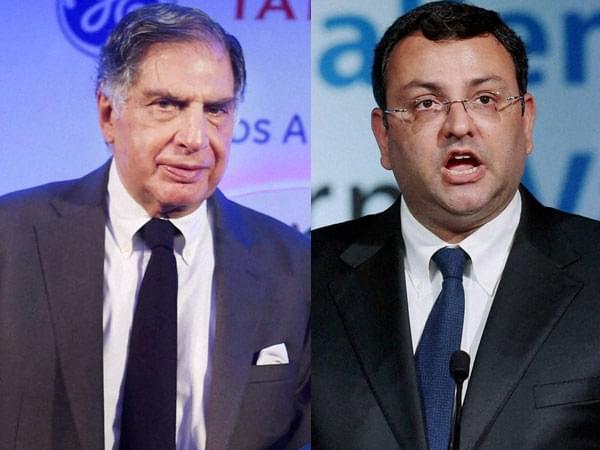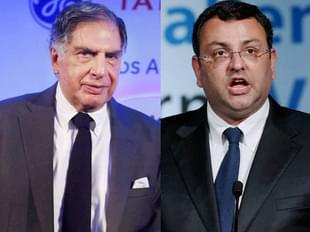Business
Explained: The Two Points Of Conflict In The Mistry-Tata Battle
Sindhu Bhattacharya
Nov 20, 2016, 11:43 AM | Updated 11:43 AM IST
Save & read from anywhere!
Bookmark stories for easy access on any device or the Swarajya app.


The Tata name has been splashed across the media for much of the last fortnight, after a shakeup at the top saw Tata Sons’ chairman Cyrus Mistry being sacked unceremoniously during a board meeting on October 24 . Two weeks later, there is still no official communication from Ratan Tata, the lifetime chairman of Tata Trusts which hold the majority 66 per cent stake in Tata Sons, about what lead to this upheaval. There have been a lot of insinuations; hints of Mistry not having followed the Tata ethos and the like, all coming from unnamed Tata officials.
Two issues that have been in the news are the supposed mishandling of the telecom venture where the Tatas’ Japanese partner, NTT DoCoMo launched arbitration proceedings abroad and the matter reached the Delhi High Court subsequently. At stake were $1.17 billion. Another controversy was about the decision to sell off Tata Steel’s United Kingdom business, something Tata insiders say is akin to selling off family jewels. Neither charge has been accepted by Mistry. He has said that each and every decision taken in the DoCoMo matter has been approved by the Tata Sons’ board and the Tata Steel UK selloff has still not happened.
So here’s a quick recap of the two issues.
TATA DOCOMO
What is the NTT DoCoMo issue all about?
Tata Teleservices entered into a joint venture with Japanese company NTT DoCoMo in 2009 under which the Japanese company acquired 26.5% stake at a price of Rs 117 per share, which means it invested about Rs 12,740 crore.
The deal that was signed at that time said that if NTT DoCoMo walked out of the joint venture within five years, the exit price of NTT DoCoMo would be half the price at which the stake was acquired or the fair market value, whichever is higher. This would work out to Rs 58 per share.
So what really triggered NTT DoCoMo’s exit?
In 2014, NTT DoCoMo decided it no longer wanted to stay invested in the venture since Tata Teleservices continued to pile up losses. According to this article, the annual report of Tata Sons said in 2013 "if certain performance parameters and other conditions are not met by March 31, 2014, should the strategic partner (NTT DoCoMo) decide to divest its entire shareholding in TTSL and should the company be unable to find a buyer for such shares, (then) the company is obligated to acquire the shareholding of the strategic partner." That DoCoMo was not keen to increase its exposure in India became clear when the Japanese company additionally decided in 2012 not to take the option to increase its equity in from 26 per cent to 33 per cent at the pre-determined price. Then, as per the share subscription agreement with NTT DoCoMo, “Tata Sons and TTSL (Tata Teleservices Ltd) jointly and severally agreed to indemnify NTT DoCoMo within the agreed limits against claims arising on account of any failure of certain warranties provided by the Tatas and TTSL to be true and correct in all respects and in respect of specified contingent liabilities".
Did the Tatas refuse to pay up?
By then, new Reserve Bank of India guidelines mandated that an international firm can only exit its investment at a valuation not exceeding that arrived at on the basis of return on equity. At that time and since 2014 too, TTSL has been piling up losses and its networth has been eroded.
So the Tatas offered only Rs 23.24 per share though under the original agreement they should have Rs 58 per share.
NTT DoCoMo did not agree with this valuation and filed for arbitration in the courts in the United Kingdom and the United States. Now, the London Court of International Arbitration (LCIA) tribunal has ordered the Tatas to pay $1.17 billion in compensation to NTT DoCoMo.
How did the matter reach the Delhi High Court?
After the LCIA verdict, the Tatas again went back to the RBI for permission to pay NTT DoCoMo Rs 58 per share, but were refused. NTT DoCoMo then submitted the LCIA order to the Delhi High Court and asked it to enforce the award. The matter is pending with the High Court and the Tatas have already deposited a sum “in excess of Rs 8000 crore” in the court as an advance. This is as per the latest communication from Mistry, who has also said that all steps taken in this matter were with the approval of the Tata Sons’ board and Tata Trusts members on the board.
The latest developments in the Tata-NTT DoCoMo saga
One of the alleged reasons of Mistry’s sacking seems to be his inability as chairman to sort out the dispute with NTT DoCoMo, whether in the arbitration courts abroad or through an out-of-court settlement. Now that Ratan Tata is back at the helm, it seems he is steering Tata Sons towards a solution, by seeking ways other than an outright purchase of the NTT DoCoMo stake at the agreed valuation. It is also being speculated that this will mean the proceedings in the Delhi High Court may be withdrawn.
Tata Steel
How did Tatas come to have a steel factory in the United Kingdom?
In 2007, when Ratan Tata was at the helm of Tata Sons, Tata Steel acquired British steel firm Corus Group plc. Corus was a loss making venture even then, but it was bought because it had excellent market share for high end steel products in the United States and Canada. But the American sub-prime crisis happened just after the Corus purchase, and the expected revival uptick in steel demand in the prime markets never happened. The Corus acquisition cost the Tatas about 12 billion pounds
Why the decision to sell off now?
Cheap Chinese steel imports began flooding the British market (much like the rest of the world) after 2008, pushing Corus further into losses. Cost of production of steel in the Britain kept rising beyond the market price. At its peak, the firm was posting a million pounds in losses daily.
When was selloff decided?
The decision to divest the British business of Tata Steel was taken about four years back, after Mistry took over as Tata Sons’ Chairman and the board agreed that this was the most prudent course of action. Feelers were sent out to potential buyers but the final decision, ratified by the Tata Sons’ board about the sell off, was taken in 2014. Mistry’s exit now comes as Tata Steel is in negotiations with German company ThyssenKrupp about merging their European steel operations. This article also says that Tata Steel is in talks with the British government about financial support for Tata Steel UK, which employs 11,000 people, and a restructuring of its pension scheme.
Has the selloff happened?
No, the British business of Tata Steel has not been sold off till now. Since 2014, various permutations and combinations have been tried. Some potential buyers wanted only parts of the business (not the whole), some wanted legacy costs like pension dues to be waived, some others expected the British government to take a hair cut and waive these dues. Then Brexit happened, and potential buyers wanted to assess the impact of this on the steel business in the United Kingdom.
So what did Mistry do wrong?
People close to the Tatas have alleged that Mistry tried selling off the United Kingdom assets of Tata Steel instead of trying to revive it, something Tata insiders themselves say is next to impossible. The prevalent view within the Tata group is that these assets should be sold off due to the global steel price crash and continuous dumping by China but now that Ratan Tata is back at Tata Sons, it is more than likely he will steer a revival of Tata Steel UK instead of a selloff.
Sindhu Bhattacharya is a senior journalist.





